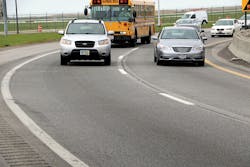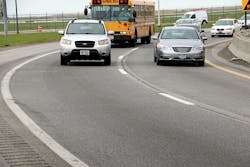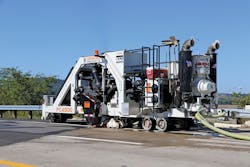In Ohio, it’s important to look at pavement solutions in relation to the current highways—only 2-3% of the pavements in the state system are concrete.
Composite pavements (asphalt over brick or concrete) represent 45-48%, and the remainder are full-depth asphalt. The Ohio Department of Transportation (ODOT) has specified longitudinal diamond grooving for concrete bridge decks, both new construction and overlays, since 2012. The safety performance of grooving on Ohio’s bridge decks has now encouraged ODOT to use the technique on several sections of asphalt pavement, all located on high-speed or tight curves where wet-weather safety is a concern.
Statistics show a clear relationship between longitudinally grooved surfaces and a reduction in accident rates. Wet-weather friction problems can cause tires to have an inadequate grip on the road, and either micro- or macrotexture issues could be the root cause.
“Covering the surface with overlays is more costly than treatments that reuse the existing surface,” said Brian Schleppi, Highway Infrastructure Management supervisor with ODOT’s Office of Technical Services. “In many applications, particularly when we’re looking for a long-term solution, grooving and grinding is the desirable option.” He noted that diamond saw blades gently abrade away the top surface of the concrete, making them less aggressive than carbide mill heads, which use impact forces to remove surface material.
He also pointed out that another benefit of diamond grooving and grinding is that the work can be performed year-round, even in low (although not freezing) temperatures, which is not the case with overlay treatments.
They’re watching
ODOT has now moved ahead by installing grooving at three locations: S.R. 126 in Hamilton County, I-90 in Cuyahoga County and I-75 in Montgomery County. The transportation department’s monitoring of these projects is ongoing, but so far, all results are encouraging.
The safety performance of grooving on Ohio bridge decks encouraged ODOT to implement the technique on several asphalt pavement sections.
S.R. 126, Hamilton County
Brianne Hetzel, assistant traffic studies engineer for ODOT District 8, explained that ODOT has been increasing its investments in systematic safety improvements (low-cost safety treatments that can be implemented across many miles) since 2006. As part of these efforts, in 2013 ODOT examined S.R. 126 in Hamilton County near the Mt. Healthy exit. A crash analysis was performed on the sweeping S-curve and a significant number of fixed-object/run-off-the road type crashes were found to be occurring in wet-road conditions. Due to the wet-road nature of the crash trend, a skid test was performed and showed concentrated areas of concern with the skid numbers.
“The district milled this location in 2010 and the wet crash trend continued, so we chose to groove it since the milling did not work previously,” said Hetzel. “Diamond grooving has been shown to improve the friction of a location (as well as ride and noise) over other methods. Since this section of S.R. 126 showed a lack of macrotexture from the skid test results, the diamond grooving option was selected.”
Post-grooving skid numbers showed nearly a 50% improvement in SN 40 smooth tire values. Grooving was performed by BOCA Construction of Norwalk, Ohio.
BOCA Construction performed grooving work for ODOT at three locations.
I-90 Innerbelt Curve, Cuyahoga County
Wet-road crashes also were occurring on the I-90 Innerbelt Curve in Cuyahoga County and some of them involved fuel spills that can soften asphalt, according to Schleppi. Various treatments were considered by ODOT to reduce accidents at this location. In 2014, James Marszal, P.E., pavement engineer for ODOT District 12, had chosen a 12.5-mm Superpave mix that required a higher-grade binder and a high-quality course aggregate known to provide improved friction characteristics. For interstate highways in Ohio, Superpave asphalt pavement is the most common material specified.
As part of a follow-up evaluation of the Superpave surface, skid testing of the pavement section was conducted and revealed a mix issue that was reducing surface macrotexture. Pavement grooving and fine planing were identified as ways to improve macrotexture and safety, and extend the life of the surface.
Schleppi proposed that while the eastbound lane receive a fine carbide mill treatment, the westbound lane would receive longitudinal diamond grooving. BOCA Construction conducted the work for both eastbound and westbound lanes. The westbound lanes of the curve were longitudinally diamond grooved in mid-November 2015, over a distance of less than ¼ mile. Because of the tight radius, there was concern at the outset of the project that the diamond cutting blades might be damaged by the torque they experienced while navigating the curved pavement sections. However, the blades performed well while making the turn and sustained no damage.
Both the eastbound and westbound pavement surfaces are performing as well as or better than expected. Crash data before and after the grooving and milling show that wet-weather crashes have, in fact, decreased. The diamond grooved section improved the average SN 40-mph smooth tire value by more than 50%, increasing it to 1 1⁄2 times its previous value. Because of this, ODOT is leaving the grooved and milled surfaces on the I-90 curve intact, despite the fact that the curve is part of a larger section of I-90 that is scheduled for preventive maintenance surface treatment in 2018. The department will continue to monitor the curve’s performance.
Statistics show a clear relationship between longitudinally grooved surfaces and a reduction in accident rates.
I-75, Montgomery County
Commercial trucks were experiencing a higher-than-expected crash rate on I-75 in Montgomery County while navigating a heavily traveled high-speed zone with multiple curves. ODOT District 7 conducted skid testing at the location. The microtexture was determined to be good, but the macrotexture required improvement, so in June 2013 grooving was performed on a stretch of road estimated to total about 2 lane-miles.
Scott LeBlanc, area engineer for ODOT District 7, modified the state’s bridge deck grooving specifications to better suit its use on asphalt. “The existing specification was developed for a rigid structure—specifically, concrete bridge decks—and not an asphalt pavement. Asphalt is inherently a more flexible material,” said LeBlanc. “We wanted to adjust the spec to avoid creating tall, slender columns of asphalt that might compress into the groove or simply fatigue and break off.”
LeBlanc specified grooves that are slightly wider than those in concrete. Grooves also were cut slightly deeper than they would be in concrete to account for the likelihood that the vertical columns of asphalt would compress into the valleys of the grooves and reduce their effective depth. Bridge deck specifications require sawing grooves at a uniform pattern spaced at 0.75 in. with tolerances of -0.25 in. or +0 in. (19 mm -6 mm or +0). Grooving for concrete decks is specified to be approximately 0.15 in. (4 mm) deep and 0.10 in. (3 mm) wide. For the grooving of asphalt on Montgomery I-75, ODOT specified a groove width of 0.125 in. and a groove depth of 0.25 in. with tolerances -0.1 in. to +0 in. Groove spacing was specified at 0.75 in. -0 in. to +0.125 in. to allow a slightly wider pattern. Actual finished grooving was 0.125 in. wide, 0.20 in. deep, spaced at 0.75 in. These dimensions/tolerances ensured that water was effectively evacuated from under the vehicle’s tires, while taking into account the flexible nature of the material to avoid creating overly slender columns.
Crash data show that the grooving, performed by BOCA Construction, has all but eliminated the issues on the northbound lanes. Southbound lanes experienced a reduction in the number of incidents as well, although changes to road geometry may be pursued in the future. ODOT District 7 engineers will begin conducting one to two skid tests per year on the I-75 curve in Montgomery County, in order to measure friction and project the remaining life span of the road surface. The diamond-grooved section improved the average SN 40 smooth tire value by more than 70%, increasing it to 1.7 times its previous value.
“Transportation engineers have used longitudinal grooving to reduce accidents and improve wet-weather traction for decades on concrete-surfaced pavements,” said John Roberts, executive director of the International Grooving & Grinding Association (IGGA). “Caltrans [the California Highway Department] documented a nearly 70% reduction in wet-weather accidents after installing safety grooving dating back to the early 1970s. Applying these treatments to asphalt-surfaced roadways has been increasing in recent years due to its effectiveness, low cost and minimal traffic disruption during construction. It is very encouraging to see ODOT continue to seek innovative, cost-competitive solutions in its pursuit to provide Ohio motorists with a safe, comfortable and sustainable transportation network.”
-------------
Information for this article provided by the International Grooving and Grinding Association.






